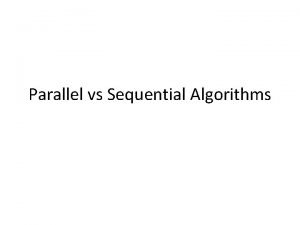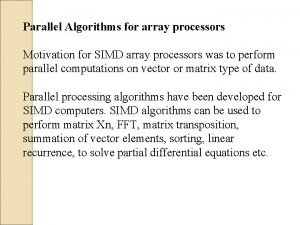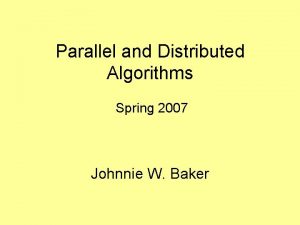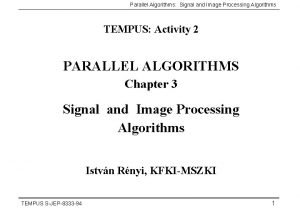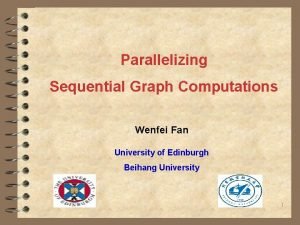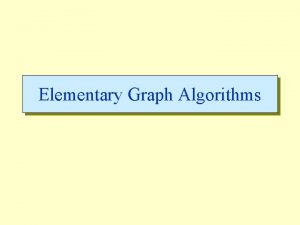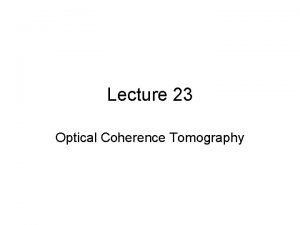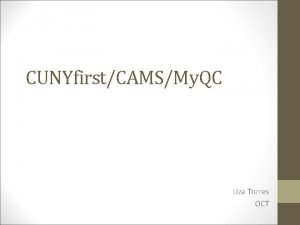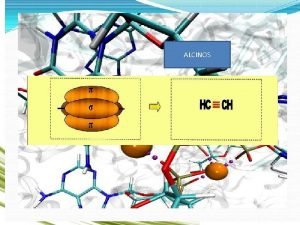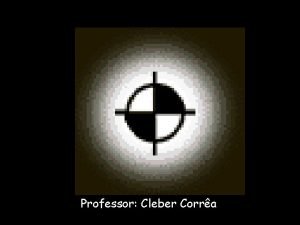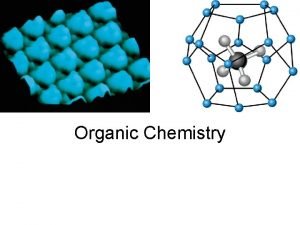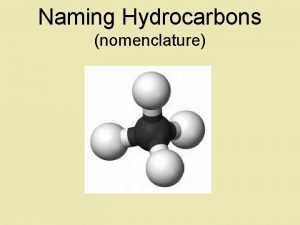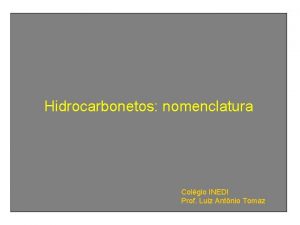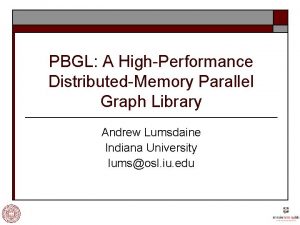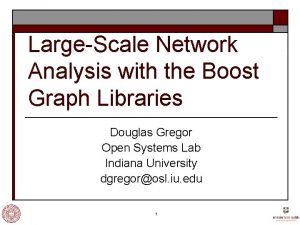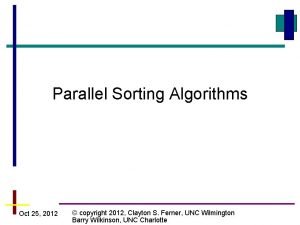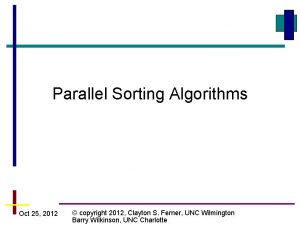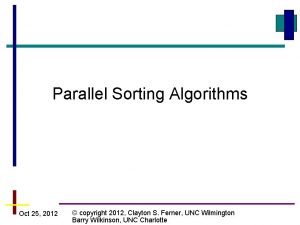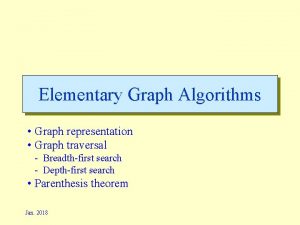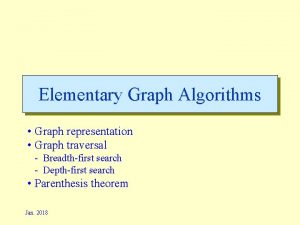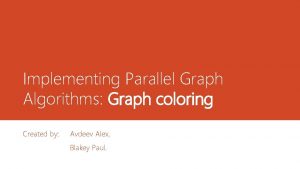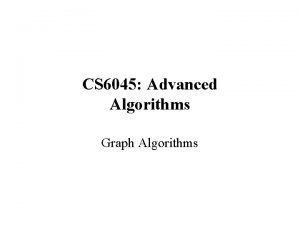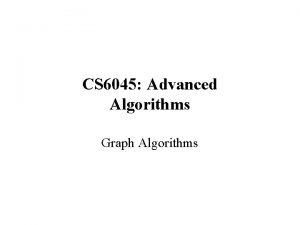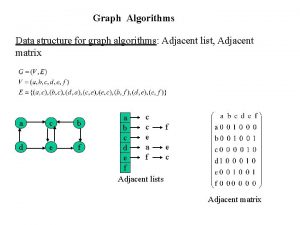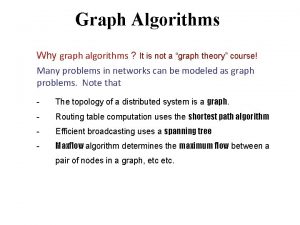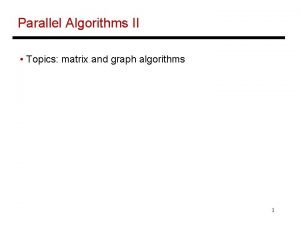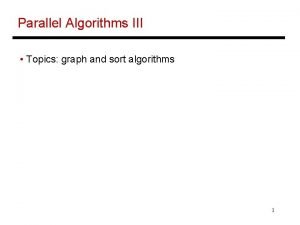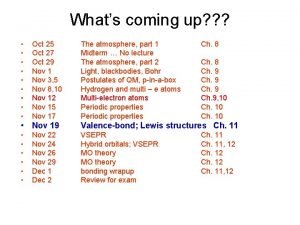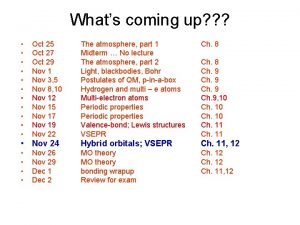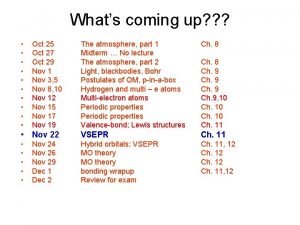Parallel Graph Algorithms Oct 25 2012 copyright 2012


















![Dijkstra’s Algorithm Dijkstra_SP(V, E, A, r) { VT = {r}; d[r] = 0; for Dijkstra’s Algorithm Dijkstra_SP(V, E, A, r) { VT = {r}; d[r] = 0; for](https://slidetodoc.com/presentation_image_h2/13fd250a0355403fbed1412dff50ed15/image-19.jpg)



































- Slides: 54

Parallel Graph Algorithms Oct 25, 2012 © copyright 2012, Clayton S. Ferner, UNC Wilmington Barry Wilkinson, UNC Charlotte

Graph Algorithms • Minimum Spanning Tree (Prim’s Algorithm) • Single-Source Shortest Path (Dijkstra’s Algorithm) • All-Pairs Shortest Paths (Dijkstra’s and Floyd’s Algorithm) Oct 25, 2012 © copyright 2012, Clayton S. Ferner, UNC Wilmington Barry Wilkinson, UNC Charlotte

Adjacency Matrix • An adjacency matrix represent the edges of a graph Oct 25, 2012 © copyright 2012, Clayton S. Ferner, UNC Wilmington Barry Wilkinson, UNC Charlotte

Adjacency Matrix • Example 0 1 1 2 4 3 Oct 25, 2012 2 2 3 4 © copyright 2012, Clayton S. Ferner, UNC Wilmington Barry Wilkinson, UNC Charlotte

Prim’s Algorithm for Minimum Spanning Tree Prim_MST(V, E, A, r) { VT = {r}; d[r] = 0; for all v in (V – VT) d[v] = Ar, v; V – set of vertices VT – set of vertices in the MST E – set of edges A – adjacency matrix r – root node d – minimum distance from MST to any vertex while (VT != V) { Find a vertex u such that d[u] = min(d[v] for all v in (V – VT)); VT = VT + {u}; for all v in (V – VT) { Complexity d[v] = min(d[v], Au, v); } } } Oct 25, 2012 © copyright 2012, Clayton S. Ferner, UNC Wilmington Barry Wilkinson, UNC Charlotte = O(n 2)

Root is node b (Prim’s) a 3 1 f b 5 c 1 2 1 d 4 5 e Since d[3] = 1, add the edge b to d and consider node d next Oct 25, 2012 © copyright 2012, Clayton S. Ferner, UNC Wilmington Barry Wilkinson, UNC Charlotte Initialize 3

Next consider node d (Prim’s) 3 1 f 3 b Take Minimums except for b and d a 5 c 1 2 1 d 4 5 e Since d[0] = 1, add the edge b to a and consider node a next Oct 25, 2012 © copyright 2012, Clayton S. Ferner, UNC Wilmington Barry Wilkinson, UNC Charlotte

Next consider node a (Prim’s) a 3 1 f 3 b 5 c 1 2 1 d 4 5 e Since d[2] = 2, add the edge d to c and consider node c next Oct 25, 2012 © copyright 2012, Clayton S. Ferner, UNC Wilmington Barry Wilkinson, UNC Charlotte

Next consider node c (Prim’s) a 3 1 f 3 b 5 c 1 2 1 d 4 5 e Since d[4] = 1, add the edge c to e and consider node e next Oct 25, 2012 © copyright 2012, Clayton S. Ferner, UNC Wilmington Barry Wilkinson, UNC Charlotte

Next consider node e (Prim’s) a 3 1 f 3 b 5 c 1 2 1 d 4 5 e Since d[5] = 3, add the edge a to f and consider node f next Oct 25, 2012 © copyright 2012, Clayton S. Ferner, UNC Wilmington Barry Wilkinson, UNC Charlotte

Next consider node f (Prim’s) a 3 1 f 3 b 5 c 1 2 1 d 4 5 e VT= V so stop Oct 25, 2012 © copyright 2012, Clayton S. Ferner, UNC Wilmington Barry Wilkinson, UNC Charlotte

Parallelizing Prim’s Algorithm • We can’t just simply execute the while loop in parallel because the d[] array changes with each selection of a vertex • We have to update values in d[] from all processors after each iteration • Suppose we have n vertices in the graph and p processors Oct 25, 2012 © copyright 2012, Clayton S. Ferner, UNC Wilmington Barry Wilkinson, UNC Charlotte

Parallelizing Prim’s Algorithm • Partition and adjacency matrix and the distance array (d) across processors d[ ] n A 0 Oct 25, 2012 1 2 © copyright 2012, Clayton S. Ferner, UNC Wilmington Barry Wilkinson, UNC Charlotte p-1

Parallelizing Prim’s Algorithm • Each processor computes the next vertex from among its vertices • A reduction is done on the distance array (d) to find the minimum • The result is broadcast out to all the processors Oct 25, 2012 © copyright 2012, Clayton S. Ferner, UNC Wilmington Barry Wilkinson, UNC Charlotte

Which pattern does this fit? Oct 25, 2012 © copyright 2012, Clayton S. Ferner, UNC Wilmington Barry Wilkinson, UNC Charlotte

Prim’s Algorithm (Parallel) Prim_MST(V, E, A, r) {. . . // Initialize d as before #pragma paraguin begin_parallel while (VT != V) { Find a vertex u such that d[u] = min(d[v] for all v in (V – VT)); VT = VT + {u}; #pragma paraguin forall for v in V if (v VT) d[v] = min(d[v], Au, v); #pragma paraguin reduce min d #pragma paraguin bcast d } #pragma paraguin end_parallel } Oct 25, 2012 © copyright 2012, Clayton S. Ferner, UNC Wilmington Barry Wilkinson, UNC Charlotte

Prim’s Algorithm (Parallel) • Complexity of Parallel algorithm: Communication Computation • Each reduction and broadcast takes log p time, but we have to do up to n of them. Oct 25, 2012 © copyright 2012, Clayton S. Ferner, UNC Wilmington Barry Wilkinson, UNC Charlotte

Dijkstra’s Algorithm for Single. Source Shortest Path • Given a source node, what is the shortest distance to each other node • The minimum spanning tree gives is this information Oct 25, 2012 © copyright 2012, Clayton S. Ferner, UNC Wilmington Barry Wilkinson, UNC Charlotte
![Dijkstras Algorithm DijkstraSPV E A r VT r dr 0 for Dijkstra’s Algorithm Dijkstra_SP(V, E, A, r) { VT = {r}; d[r] = 0; for](https://slidetodoc.com/presentation_image_h2/13fd250a0355403fbed1412dff50ed15/image-19.jpg)
Dijkstra’s Algorithm Dijkstra_SP(V, E, A, r) { VT = {r}; d[r] = 0; for v in (V – VT) d[v] = Ar, v; V – set of vertices VT – set of vertices in the MST E – set of edges A – adjacency matrix r – root node d – minimum distance from root to any vertex while (VT != V) { Find a vertex v such that d[u] = min(d[v] for all v in (V – VT)); VT = VT + {u}; for v in (V – VT) Complexity d[v] = min(d[v], d[u] + Au, v); } } Oct 25, 2012 This is the only thing different © copyright 2012, Clayton S. Ferner, UNC Wilmington Barry Wilkinson, UNC Charlotte = O(n 2)

Source Node is node b (Dijkstra’s) a 3 1 f b 5 c 1 2 1 d 4 5 e Since d[3] = 1, consider node d next Oct 25, 2012 © copyright 2012, Clayton S. Ferner, UNC Wilmington Barry Wilkinson, UNC Charlotte Initialize 3

Next consider node d (Dijkstra’s) a 3 1 f 3 b 5 c 1 2 1 d 4 5 e Since l[0] = 1, consider node a next Oct 25, 2012 © copyright 2012, Clayton S. Ferner, UNC Wilmington Barry Wilkinson, UNC Charlotte

Next consider node a (Dijkstra’s) a 3 1 f 3 b 5 c 1 2 1 d 4 5 e Since l[2] = 3, consider node c next Oct 25, 2012 © copyright 2012, Clayton S. Ferner, UNC Wilmington Barry Wilkinson, UNC Charlotte

Next consider node c (Dijkstra’s) a 3 1 f 3 b 5 c 1 2 1 d 4 5 e Since l[4] = 4, consider node e next Oct 25, 2012 © copyright 2012, Clayton S. Ferner, UNC Wilmington Barry Wilkinson, UNC Charlotte

Next consider node e (Dijkstra’s) a 3 1 f 3 b 5 c 1 2 1 d 4 5 e Since d[5] = 4, add the edge a to f and consider node f next Oct 25, 2012 © copyright 2012, Clayton S. Ferner, UNC Wilmington Barry Wilkinson, UNC Charlotte

Next consider node f (Dijkstra’s) a 3 1 f 3 b 5 c 1 2 1 d 4 5 e VT= V so stop Oct 25, 2012 © copyright 2012, Clayton S. Ferner, UNC Wilmington Barry Wilkinson, UNC Charlotte

Parallelizing Dijkstra’s Algorithm • Since Dijkstra’s Algorithm and Prim’s Algorithm are essentially the same, we can parallelize them the same way: • Complexity of Parallel algorithm: Communication Computation • If we have n processors, this becomes: Oct 25, 2012 © copyright 2012, Clayton S. Ferner, UNC Wilmington Barry Wilkinson, UNC Charlotte

All Pairs Shortest Path • Dijkstra’s Algorithm gives us the shortest path from a particular node to all the others • For All Paris Shortest Path, we want to find the shortest path between all pairs of vertices • We can apply Dijkstra’s Algorithm to every pair of vertices • Complexity = O(n 3) Oct 25, 2012 © copyright 2012, Clayton S. Ferner, UNC Wilmington Barry Wilkinson, UNC Charlotte

All Pairs using Dijkstra’s Algorithm Dijkstra_APSP(V, E, A) V – set of vertices { VT – set of vertices in the MST for r in V { E – set of edges VT = {r}; A – adjacency matrix d[N] = {0, … }; r – root node for all v in (V – VT) d – minimum distance from root to d[r][v] = Ar, v; any vertex while (VT != V) { Find a vertex u such that d[r][u] = min(d[r][v] for all v in (V – VT)); VT = VT + {u}; for v in (V – VT) d[r][v] = min(d[v], d[u] + Au, v); } } Complexity = O(n 3) } Oct 25, 2012 © copyright 2012, Clayton S. Ferner, UNC Wilmington Barry Wilkinson, UNC Charlotte

All Pairs Shortest Path • We can parallelize the outermost loop • Each processors assumes a different node vi and computes the shortest path to all nodes • No communication if needed • Complexity is O(n 3/p) • If we have n processors, complexity is O(n 2) • If we have n 2 processors, we can use n processors for each vertex. Complexity becomes O(nlogn) Oct 25, 2012 © copyright 2012, Clayton S. Ferner, UNC Wilmington Barry Wilkinson, UNC Charlotte

Floyd’s Algorithm for All Pairs Shortest Path • Floyd’s Algorithm works off of this observation: – Consider a subset of V: – Let be the weight of the shortest path from vi to vj that includes one of the vertices in – If vk is not in the shortest path from vi to vj, then – Otherwise, the shortest path is Oct 25, 2012 © copyright 2012, Clayton S. Ferner, UNC Wilmington Barry Wilkinson, UNC Charlotte

Floyd’s Algorithm for All Pairs Shortest Path • This leads to the following recurrence: • We can implement this using iteration and not recursion Oct 25, 2012 © copyright 2012, Clayton S. Ferner, UNC Wilmington Barry Wilkinson, UNC Charlotte

k=0 (Floyds’s) a 3 1 f 3 b 5 c 1 2 1 d 4 5 e d 0 is just the distance matrix A Oct 25, 2012 © copyright 2012, Clayton S. Ferner, UNC Wilmington Barry Wilkinson, UNC Charlotte

k = 1 (consider node a) (Floyds’s) a 3 i 1 f 3 b 5 c 1 2 1 d 4 5 e b to c and b to f is shorter by going through a Oct 25, 2012 © copyright 2012, Clayton S. Ferner, UNC Wilmington Barry Wilkinson, UNC Charlotte

k = 1 (consider node a) (Floyds’s) a 3 1 f 3 b i 5 c 1 2 1 d 4 5 e c to b and c to f is shorter by going through a Oct 25, 2012 © copyright 2012, Clayton S. Ferner, UNC Wilmington Barry Wilkinson, UNC Charlotte

k = 1 (consider node a) (Floyds’s) a 3 1 f 3 b 5 c 1 2 1 d 4 5 i i e Neither d nor e can get to a, so move on Oct 25, 2012 © copyright 2012, Clayton S. Ferner, UNC Wilmington Barry Wilkinson, UNC Charlotte

k = 1 (consider node a) (Floyds’s) a 3 1 f 3 b 5 c 1 2 1 d 4 5 e i f to b and f to c is shorter by going through a Oct 25, 2012 © copyright 2012, Clayton S. Ferner, UNC Wilmington Barry Wilkinson, UNC Charlotte

k = 2 (consider node b) (Floyds’s) i a 3 1 f 3 b 5 c 1 2 1 d 4 5 e a to d is shorter by going through b Oct 25, 2012 © copyright 2012, Clayton S. Ferner, UNC Wilmington Barry Wilkinson, UNC Charlotte

k = 2 (consider node b) (Floyds’s) a 3 1 f 3 b 5 i c 1 2 1 d 4 5 e a to d is shorter by going through b Oct 25, 2012 © copyright 2012, Clayton S. Ferner, UNC Wilmington Barry Wilkinson, UNC Charlotte

k = 2 (consider node b) (Floyds’s) a 3 1 f 3 b 5 c 1 2 1 d 4 5 e i a to d is shorter by going through b Oct 25, 2012 © copyright 2012, Clayton S. Ferner, UNC Wilmington Barry Wilkinson, UNC Charlotte

All Pairs using Floyd’s Algorithm Floyd_APSP(V, E, A) { d 0 i, j = Ai, j for all i, j for k = 1 to n for i = 1 to n for j = 1 to n d(k)i, j = min(d(k-1)i, j V – set of vertices E – set of edges A – adjacency matrix , d(k-1)i, k + d(k-1)k, j ) Complexity = O(n 3) • We don’t need n copies of the d matrix. We only need one. • In fact, we can do it with only one matrix Oct 25, 2012 © copyright 2012, Clayton S. Ferner, UNC Wilmington Barry Wilkinson, UNC Charlotte

Partitioning of the d matrix Oct 25, 2012 … • We divide the d matrix into p blocks of size n/√p • Each processor is responsible for n 2/√p elements of the d matrix … … … © copyright 2012, Clayton S. Ferner, UNC Wilmington Barry Wilkinson, UNC Charlotte

Partitioning of the d matrix k column • However, we have to send data between processors Oct 25, 2012 j column k row i row © copyright 2012, Clayton S. Ferner, UNC Wilmington Barry Wilkinson, UNC Charlotte

Which pattern does this fit? Oct 25, 2012 © copyright 2012, Clayton S. Ferner, UNC Wilmington Barry Wilkinson, UNC Charlotte

Communication Pattern … … Oct 25, 2012 © copyright 2012, Clayton S. Ferner, UNC Wilmington Barry Wilkinson, UNC Charlotte

Analysis of Floyd’s Algorithm • Each processor has to send its block to all processors on the same row and column. • If we use a broadcast, then the time for communication is • The synchronization step requires • The time to compute the new values for each step is Oct 25, 2012 © copyright 2012, Clayton S. Ferner, UNC Wilmington Barry Wilkinson, UNC Charlotte

Analysis of Floyd’s Algorithm • So the complexity for each step is: • And finally, the complexity for n steps (of the k loop) is: Communication Computation Oct 25, 2012 © copyright 2012, Clayton S. Ferner, UNC Wilmington Barry Wilkinson, UNC Charlotte

A faster version of Floyd’s Algorithm • We can do a pipeline of values moving through the matrix. • The reason is because once processor pi, j computes the value of it can then send it to the processors pi, j-1 , pi, j+1 , pi+1, j , and pi-1, j Oct 25, 2012 © copyright 2012, Clayton S. Ferner, UNC Wilmington Barry Wilkinson, UNC Charlotte

Consider the movement of the value computed by processor 4 Time t t+1 t+2 t+3 t+4 1 2 3 4 5 6 Processors Oct 25, 2012 © copyright 2012, Clayton S. Ferner, UNC Wilmington Barry Wilkinson, UNC Charlotte 7 8

Analysis of Floyd’s Algorithm with pipelining • The net complexity of the algorithm using pipelining is: Communication Computation Oct 25, 2012 © copyright 2012, Clayton S. Ferner, UNC Wilmington Barry Wilkinson, UNC Charlotte

• We divide the d matrix into p rows instead of blocks • Each processor is responsible for n 2/p elements of the d matrix Oct 25, 2012 … Row Partitioning of the d matrix © copyright 2012, Clayton S. Ferner, UNC Wilmington Barry Wilkinson, UNC Charlotte

Partitioning of the d matrix k column • Now we are only sending between rows • But this still requires broadcasting or a pipeline Oct 25, 2012 j column k row i row © copyright 2012, Clayton S. Ferner, UNC Wilmington Barry Wilkinson, UNC Charlotte

… … Communication Pattern Oct 25, 2012 © copyright 2012, Clayton S. Ferner, UNC Wilmington Barry Wilkinson, UNC Charlotte

All Pairs using Floyd’s Algorithm Floyd_APSP(V, E, A) V – set of vertices { E – set of edges 0 d i, j = Ai, j for all i, j A – adjacency matrix for k = 1 to n #pragma omp parallel for private (i, j) for i = 1 to n for j = 1 to n d(k)i, j = min(d(k-1)i, j , d(k-1)i, k + d(k-1)k, j ) • Given the amount of communication, this algorithm would best be done on a sharedmemory system Oct 25, 2012 © copyright 2012, Clayton S. Ferner, UNC Wilmington Barry Wilkinson, UNC Charlotte

Questions Oct 25, 2012 © copyright 2012, Clayton S. Ferner, UNC Wilmington Barry Wilkinson, UNC Charlotte
 Parallel vs sequential algorithms
Parallel vs sequential algorithms Simd parallel algorithms
Simd parallel algorithms Parallel and distributed algorithms
Parallel and distributed algorithms Parallel image processing algorithms
Parallel image processing algorithms Dentist copyright 2012
Dentist copyright 2012 Copyright 2012
Copyright 2012 Copyright 2012
Copyright 2012 Copyright 2012
Copyright 2012 Elementary graph algorithms
Elementary graph algorithms When graphs are life
When graphs are life Elementary graph algorithms
Elementary graph algorithms Undirected graph algorithms
Undirected graph algorithms Pent oct hept hex
Pent oct hept hex 2nd october 1869
2nd october 1869 Działania na systemach liczbowych
Działania na systemach liczbowych October 3rd 1993
October 3rd 1993 Principle of oct
Principle of oct Propylhexane formule semi-développée
Propylhexane formule semi-développée Sunset oct 31
Sunset oct 31 Premium sanitas
Premium sanitas Visante oct
Visante oct Oct stands for
Oct stands for Grupo funcional
Grupo funcional Stil testi
Stil testi Meth eth prop but pent hex hept oct non dec
Meth eth prop but pent hex hept oct non dec Organic chemistry vs biochemistry
Organic chemistry vs biochemistry Oct vizsgálat ára
Oct vizsgálat ára Organic chemistry meth eth prop but
Organic chemistry meth eth prop but Jhlt. 2019 oct; 38(10): 1015-1066
Jhlt. 2019 oct; 38(10): 1015-1066 Jhlt. 2019 oct; 38(10): 1015-1066
Jhlt. 2019 oct; 38(10): 1015-1066 Jhlt. 2019 oct; 38(10): 1015-1066
Jhlt. 2019 oct; 38(10): 1015-1066 Metil acetileno
Metil acetileno Met et prop but pent hex hept oct non dec
Met et prop but pent hex hept oct non dec Formula of butanoic acid
Formula of butanoic acid Saturated hydrocarbon formula
Saturated hydrocarbon formula Prop but pent hex hept oct
Prop but pent hex hept oct Meth eth prop but mnemonic
Meth eth prop but mnemonic Eth meth prop but
Eth meth prop but Met et prop but pent hex hept oct non dec
Met et prop but pent hex hept oct non dec Characteristics of homologous series
Characteristics of homologous series Met et prop but pent hex hept oct non dec
Met et prop but pent hex hept oct non dec Jhlt. 2019 oct; 38(10): 1015-1066
Jhlt. 2019 oct; 38(10): 1015-1066 Scleral lens oct
Scleral lens oct Parallel data warehouse sql server 2012
Parallel data warehouse sql server 2012 What are like and unlike forces
What are like and unlike forces It refers to inner terminus
It refers to inner terminus Non parallel sentence
Non parallel sentence What is parallel structure
What is parallel structure Parallel structure means
Parallel structure means Serial in serial out shift register truth table
Serial in serial out shift register truth table Parallel structures
Parallel structures Pbgl
Pbgl Parallel boost graph library
Parallel boost graph library Handshaking theorem
Handshaking theorem Resource allocation graph and wait for graph
Resource allocation graph and wait for graph
